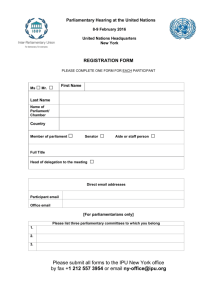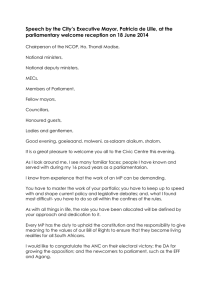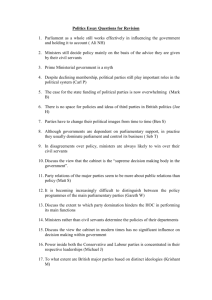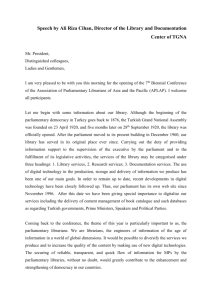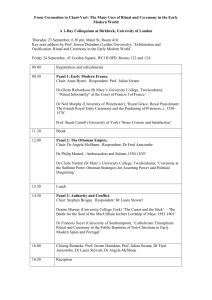1 **To order copies of these GCRP working papers please contact... the details below quoting the Code number of the requested...
advertisement
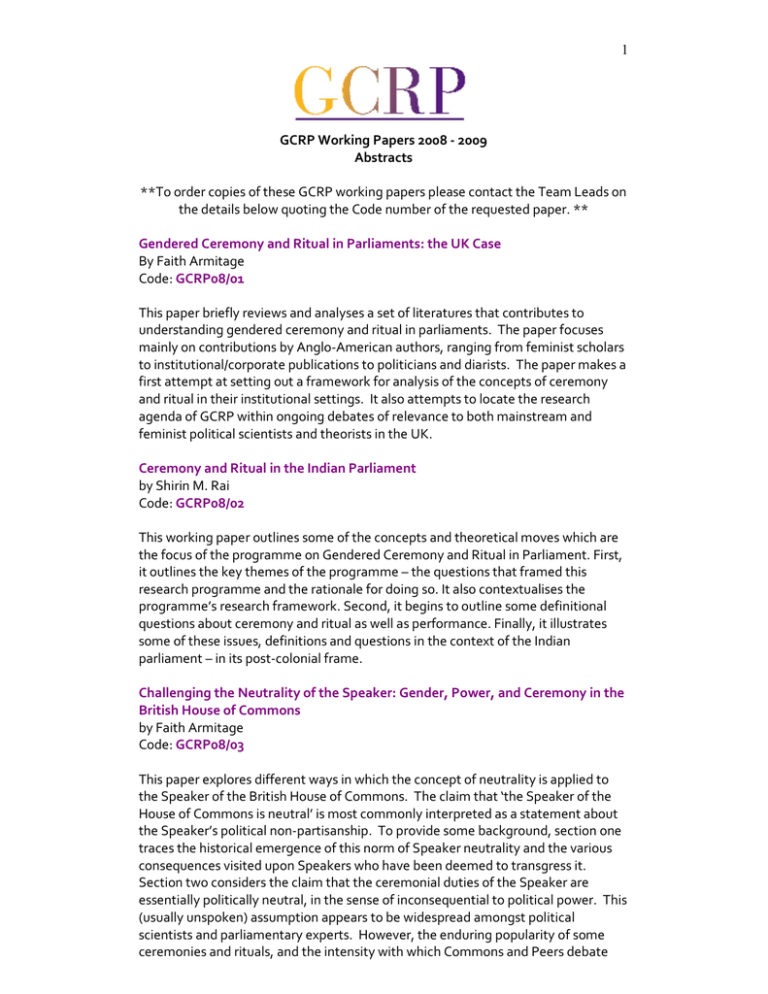
1 GCRP Working Papers 2008 - 2009 Abstracts **To order copies of these GCRP working papers please contact the Team Leads on the details below quoting the Code number of the requested paper. ** Gendered Ceremony and Ritual in Parliaments: the UK Case By Faith Armitage Code: GCRP08/01 This paper briefly reviews and analyses a set of literatures that contributes to understanding gendered ceremony and ritual in parliaments. The paper focuses mainly on contributions by Anglo-American authors, ranging from feminist scholars to institutional/corporate publications to politicians and diarists. The paper makes a first attempt at setting out a framework for analysis of the concepts of ceremony and ritual in their institutional settings. It also attempts to locate the research agenda of GCRP within ongoing debates of relevance to both mainstream and feminist political scientists and theorists in the UK. Ceremony and Ritual in the Indian Parliament by Shirin M. Rai Code: GCRP08/02 This working paper outlines some of the concepts and theoretical moves which are the focus of the programme on Gendered Ceremony and Ritual in Parliament. First, it outlines the key themes of the programme – the questions that framed this research programme and the rationale for doing so. It also contextualises the programme’s research framework. Second, it begins to outline some definitional questions about ceremony and ritual as well as performance. Finally, it illustrates some of these issues, definitions and questions in the context of the Indian parliament – in its post-colonial frame. Challenging the Neutrality of the Speaker: Gender, Power, and Ceremony in the British House of Commons by Faith Armitage Code: GCRP08/03 This paper explores different ways in which the concept of neutrality is applied to the Speaker of the British House of Commons. The claim that ‘the Speaker of the House of Commons is neutral’ is most commonly interpreted as a statement about the Speaker’s political non-partisanship. To provide some background, section one traces the historical emergence of this norm of Speaker neutrality and the various consequences visited upon Speakers who have been deemed to transgress it. Section two considers the claim that the ceremonial duties of the Speaker are essentially politically neutral, in the sense of inconsequential to political power. This (usually unspoken) assumption appears to be widespread amongst political scientists and parliamentary experts. However, the enduring popularity of some ceremonies and rituals, and the intensity with which Commons and Peers debate 2 their alteration or abolition, is indicative of their power. Section three considers the claim that political offices in formally egalitarian, liberal democracies are gender neutral, in the sense of being open equally to women and men. Feminists have unmasked these pretensions to gender neutrality and uncovered the unmistakeably masculine norms and forms constituting our central political roles and institutions. However, feminists have not analysed the office of the Speaker specifically, so I extend their frameworks of analysis to the Speaker with some unexpected and contradictory results concerning the putative masculinity of the office. While the argument of the paper is not cumulative - these different debates about neutrality proceed independently of one another -- a common theme that runs throughout is a broader scepticism about claims of neutrality. Gendered Ceremony and Ritual in Parliament: Concepts and a Catalogue of UK Parliamentary Ceremonies by Faith Armitage and Rosa Malley Code: GCRP08/04 This paper investigates the concepts of ‘ceremony’ and ‘ritual’. Review of the literature on ceremony and ritual reveals high levels of disagreement regarding definitions and functions, within and between different disciplines. Ceremony and ritual are often used in different ways and sometimes interchangeably. The ambiguity is confusing, but positive in that it leaves the terms open to debate and malleability for our purposes. It is necessary to develop distinctive working definitions of ceremony and ritual to answer GCRP’s research questions. Thus, in Part I of this paper, we review how the terms are most commonly employed and try to settle on interpretations and definitions that will facilitate our research. Part II provides a catalogue of the most well-known and distinctive ceremonies and rituals in the British Parliament. Symbolising the Rainbow: Glimpses of South African Parliament by Surya Monro Code: GCRP08/05 Ritual and ceremony may seem like strange topics for political scientists, who are more usually concerned with issues of representation and accountability. Cultural aspects of parliament, such as language, dress and song can be seen as superfluous by-products of the more important ‘business of parliament’. However, the soft aspects of parliamentary culture and institutional norms form an aspect of the processes by which parliamentary politics are constituted and signified to the public. Attention to manifestations of culture, such as ritual and ceremony, may provide a means of gaining insight into the ways in which parliament reflects and forms power relations, and the inclusion and exclusion of socially marginalised groups. This paper provides an historical overview of the development of parliamentary ritual and ceremony within South Africa. The paper addresses an area in which there has been a paucity of research: ceremony and ritual within parliament. By describing ceremony and ritual in South African parliament, the paper provides a foundation for addressing the hypothesis that representative institutions operate through evolving repertoires of ritual and ceremony which control the members (performance) and signify their function to the public (audience)1. I conclude with tentative thoughts 1 Research proposal: Gendered Ceremony and Ritual in Parliament: Disciplining Representation. 3 about possible directions for research concerning ritual and ceremony in South African parliament. Disrupting rituals of parliamentary debate: the Indian parliament by Carole Spary Code: GCRP08/06 This paper discusses the significance of increasing disruptions to parliamentary debate and forced adjournments witnessed in the last two decades in the Indian Parliament. Chamber debate is one of many rituals which embody the symbolic norm of democratic representation in parliamentary institutions. The analysis explores the extent to which norms embedded within parliamentary ritual may discipline the actions of its participants, and to what extent these norms might privilege some groups and marginalise and exclude other groups. Formal norms of parliamentary debate in the Indian parliament are identified through an analysis of parliamentary documentation on rules, procedures, and conventions as well as training material for members of parliament. This analysis is then juxtaposed against a discussion of increasing disruptions to parliamentary debate in the house, focusing on how, when and why disruptions take place, who gets to disrupt, and how disruptive strategies are interpreted by members of parliament. The main findings are contextualised in light of broader recent changes in democratic representation in. the Indian political system. Are Parliament’s Ceremonies and Rituals a Problem for British Democracy? By Faith Armitage Code: GCRP09/07 THE RECENT LITERATURE about British democracy is preoccupied with two key problems: 1. Why is the British public disengaged from formal politics? 2. Is parliament in decline? In places, these individually complex problems overlap and generate a tangled set of conundrums about the British political system and the health of its main institutions, including parties, the executive, and parliament. This paper explores what links can be made and what hypotheses advanced about the role that Westminster’s distinct parliamentary traditions play (or perhaps more pertinently, do not play) in these contested dynamics. While this might seem an eccentric turn to take, the fact is that politicians and the media routinely suggest that Westminster’s peculiar ways contribute to one or both of public disengagement and parliamentary decline. Section one reviews the recent debates and outlines the reasons for asking the title’s question. Section two indicates the materials from which an answer might be constructed. If parliament’s ceremonies and rituals contribute to the problems facing British democracy, it must be because they are problematic for the public, parliamentarians, or both. The paper reveals that there is no data to support either the optimistic (‘the people admire parliamentary ceremony’) or the pessimistic (‘the people loathe parliamentary ceremony’) thesis. In fact, relatively little is known about the public’s views on parliament, period. By contrast, there is copious information about MPs’ views about their institution’s peculiar practices and traditions, so the problem here is sifting through it to uncover politically significant patterns. Focusing on MPs’ beliefs about the role of ceremony and ritual on inclusion/exclusion and on effectiveness, the paper shows that a finegrained approach must be employed since the impact of ceremony and ritual on these dimensions of parliamentary life is varied. 4 Regional identity in parliamentary ceremony and ritual: a study of diversity and representation of the Indian Parliament By Carole Spary Code: GCRP09/08 This paper analyses the significance of sub-national regional identity and the politics of multilingualism within the context of the Indian parliament. It explores the symbolic representation of regional identity in the Indian parliament through an analysis of language practices in parliamentary debate. Since the 1960s, the Indian parliament has been increasingly accommodative of demands for operational multilingualism which has allowed members to express themselves in a number of different languages during debates. While the vast majority of debate in the Indian parliament takes place in English or Hindi, facilities are available for simultaneous interpretation and translation into a number of other recognised Indian regional languages. This development has been largely a product of institutional evolution rather than original design, and has been heavily influenced by extra-parliamentary events during the 1950s and 1960s. After briefly tracing the evolution of the accommodation of linguistic diversity in the Indian parliament, I present analysis of empirical data on the usage of different regional languages in parliamentary ceremonies and ritualised debates in the lower house of Parliament (Lok Sabha), during the last parliament (2004-2009). Findings suggest considerable diversity into how regional languages are used in debate, in terms of individual languages used, during particular ceremonies and types of debates, and by different members. Despite such diversity, it convincingly demonstrates the enduring importance of multilingual provisions in parliament among MPs, particularly beyond functional linguistic capacity, and even among those MPs that do not regularly use regional languages. It also raises interesting questions as to how the performance of ethnolinguistic identity intersects with the performance other identities such as caste and gender, as well as wider implications for the performance of political representation. India Team Working papers contact: Prof. Shirin Rai E: shirin.rai@warwick.ac.uk South Africa Team Working papers contact: Prof. Georgina Waylen E: g.waylen@sheffield.ac.uk UK Team Working papers contact: Prof. Sarah Childs E: s.childs@bristol.ac.uk Or Prof. Joni Lovenduski E: j.lovenduski@bbk.ac.uk

